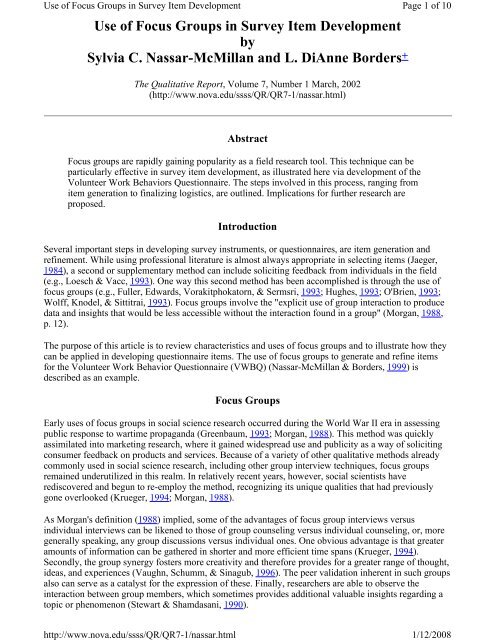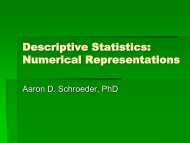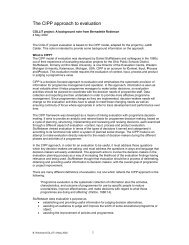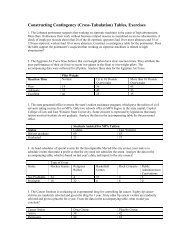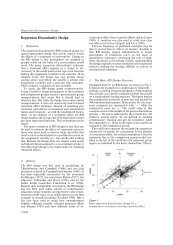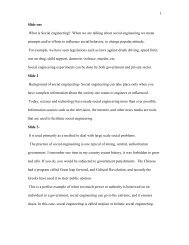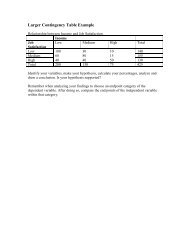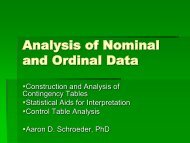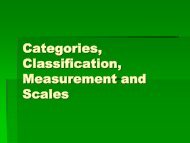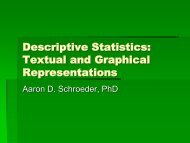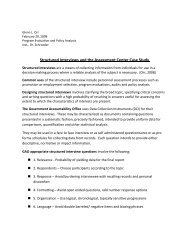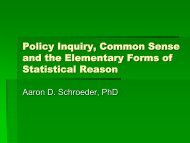Use of Focus Groups in Survey Development.pdf
Use of Focus Groups in Survey Development.pdf
Use of Focus Groups in Survey Development.pdf
You also want an ePaper? Increase the reach of your titles
YUMPU automatically turns print PDFs into web optimized ePapers that Google loves.
http://www.nova.edu/ssss/QR/QR7-1/nassar.html<br />
1/12/2008<br />
<strong>Use</strong> <strong>of</strong> <strong>Focus</strong> <strong>Groups</strong> <strong>in</strong> <strong>Survey</strong> Item <strong>Development</strong><br />
<strong>Use</strong> <strong>of</strong> <strong>Focus</strong> <strong>Groups</strong> <strong>in</strong> <strong>Survey</strong> Item <strong>Development</strong><br />
by<br />
Sylvia C. Nassar-McMillan and L. DiAnne Borders +<br />
The Qualitative Report, Volume 7, Number 1 March, 2002<br />
(http://www.nova.edu/ssss/QR/QR7-1/nassar.html)<br />
Page 1 <strong>of</strong> 10<br />
Abstract<br />
<strong>Focus</strong> groups are rapidly ga<strong>in</strong><strong>in</strong>g popularity as a field research tool. This technique can be<br />
particularly effective <strong>in</strong> survey item development, as illustrated here via development <strong>of</strong> the<br />
Volunteer Work Behaviors Questionnaire. The steps <strong>in</strong>volved <strong>in</strong> this process, rang<strong>in</strong>g from<br />
item generation to f<strong>in</strong>aliz<strong>in</strong>g logistics, are outl<strong>in</strong>ed. Implications for further research are<br />
proposed.<br />
Introduction<br />
Several important steps <strong>in</strong> develop<strong>in</strong>g survey <strong>in</strong>struments, or questionnaires, are item generation and<br />
ref<strong>in</strong>ement. While us<strong>in</strong>g pr<strong>of</strong>essional literature is almost always appropriate <strong>in</strong> select<strong>in</strong>g items (Jaeger,<br />
1984), a second or supplementary method can <strong>in</strong>clude solicit<strong>in</strong>g feedback from <strong>in</strong>dividuals <strong>in</strong> the field<br />
(e.g., Loesch & Vacc, 1993). One way this second method has been accomplished is through the use <strong>of</strong><br />
focus groups (e.g., Fuller, Edwards, Vorakitphokatorn, & Sermsri, 1993; Hughes, 1993; O'Brien, 1993;<br />
Wolff, Knodel, & Sittitrai, 1993). <strong>Focus</strong> groups <strong>in</strong>volve the "explicit use <strong>of</strong> group <strong>in</strong>teraction to produce<br />
data and <strong>in</strong>sights that would be less accessible without the <strong>in</strong>teraction found <strong>in</strong> a group" (Morgan, 1988,<br />
p. 12).<br />
The purpose <strong>of</strong> this article is to review characteristics and uses <strong>of</strong> focus groups and to illustrate how they<br />
can be applied <strong>in</strong> develop<strong>in</strong>g questionnaire items. The use <strong>of</strong> focus groups to generate and ref<strong>in</strong>e items<br />
for the Volunteer Work Behavior Questionnaire (VWBQ) (Nassar-McMillan & Borders, 1999) is<br />
described as an example.<br />
<strong>Focus</strong> <strong>Groups</strong><br />
Early uses <strong>of</strong> focus groups <strong>in</strong> social science research occurred dur<strong>in</strong>g the World War II era <strong>in</strong> assess<strong>in</strong>g<br />
public response to wartime propaganda (Greenbaum, 1993; Morgan, 1988). This method was quickly<br />
assimilated <strong>in</strong>to market<strong>in</strong>g research, where it ga<strong>in</strong>ed widespread use and publicity as a way <strong>of</strong> solicit<strong>in</strong>g<br />
consumer feedback on products and services. Because <strong>of</strong> a variety <strong>of</strong> other qualitative methods already<br />
commonly used <strong>in</strong> social science research, <strong>in</strong>clud<strong>in</strong>g other group <strong>in</strong>terview techniques, focus groups<br />
rema<strong>in</strong>ed underutilized <strong>in</strong> this realm. In relatively recent years, however, social scientists have<br />
rediscovered and begun to re-employ the method, recogniz<strong>in</strong>g its unique qualities that had previously<br />
gone overlooked (Krueger, 1994; Morgan, 1988).<br />
As Morgan's def<strong>in</strong>ition (1988) implied, some <strong>of</strong> the advantages <strong>of</strong> focus group <strong>in</strong>terviews versus<br />
<strong>in</strong>dividual <strong>in</strong>terviews can be likened to those <strong>of</strong> group counsel<strong>in</strong>g versus <strong>in</strong>dividual counsel<strong>in</strong>g, or, more<br />
generally speak<strong>in</strong>g, any group discussions versus <strong>in</strong>dividual ones. One obvious advantage is that greater<br />
amounts <strong>of</strong> <strong>in</strong>formation can be gathered <strong>in</strong> shorter and more efficient time spans (Krueger, 1994).<br />
Secondly, the group synergy fosters more creativity and therefore provides for a greater range <strong>of</strong> thought,<br />
ideas, and experiences (Vaughn, Schumm, & S<strong>in</strong>agub, 1996). The peer validation <strong>in</strong>herent <strong>in</strong> such groups<br />
also can serve as a catalyst for the expression <strong>of</strong> these. F<strong>in</strong>ally, researchers are able to observe the<br />
<strong>in</strong>teraction between group members, which sometimes provides additional valuable <strong>in</strong>sights regard<strong>in</strong>g a<br />
topic or phenomenon (Stewart & Shamdasani, 1990).
http://www.nova.edu/ssss/QR/QR7-1/nassar.html<br />
1/12/2008<br />
<strong>Use</strong> <strong>of</strong> <strong>Focus</strong> <strong>Groups</strong> <strong>in</strong> <strong>Survey</strong> Item <strong>Development</strong><br />
<strong>Use</strong>s <strong>of</strong> <strong>Focus</strong> <strong>Groups</strong><br />
Page 2 <strong>of</strong> 10<br />
Researchers <strong>of</strong>ten are <strong>in</strong> need <strong>of</strong> <strong>in</strong>novative approaches to gather <strong>in</strong>itial data, especially when little<br />
<strong>in</strong>formation on a specific topic <strong>of</strong> <strong>in</strong>terest is known. <strong>Focus</strong> groups potentially provide such an exploratory<br />
approach and may be more effective <strong>in</strong> certa<strong>in</strong> research processes than more traditional approaches<br />
(Greenbaum, 1993; Vaughn, et al., 1996). <strong>Focus</strong> groups may be used to ref<strong>in</strong>e <strong>in</strong>formation previously<br />
known about a topic or may be designed to elicit new <strong>in</strong>sight and <strong>in</strong>formation about a topic by exam<strong>in</strong><strong>in</strong>g<br />
it from a new angle.<br />
<strong>Focus</strong> groups can <strong>of</strong>fer an appropriate medium for work at various steps <strong>of</strong> the research process, from<br />
hypothesis generation to hypothesis test<strong>in</strong>g (Krueger, 1994). More specifically, focus groups can be<br />
appropriate for obta<strong>in</strong><strong>in</strong>g <strong>in</strong>formation, generat<strong>in</strong>g research hypotheses, stimulat<strong>in</strong>g new ideas or concepts,<br />
diagnos<strong>in</strong>g problems with or gather<strong>in</strong>g <strong>in</strong>formation about services or programs, provid<strong>in</strong>g term<strong>in</strong>ology<br />
appropriate for the research, and <strong>in</strong>terpret<strong>in</strong>g experimental results (Stewart & Shamdasani, 1990). <strong>Focus</strong><br />
groups can supplement quantitative or other qualitative techniques; or they can be utilized as a selfconta<strong>in</strong>ed<br />
technique, result<strong>in</strong>g <strong>in</strong> data that are useful <strong>in</strong> and <strong>of</strong> itself (Morgan, 1988; Vaughn, et al., 1996).<br />
Individual focus groups can be drawn from specific populations; a series <strong>of</strong> focus groups can serve to<br />
compare the groups' reactions to the same concepts. In comb<strong>in</strong><strong>in</strong>g focus groups with surveys, group<br />
members not only can help provide language appropriate to their population, as noted, but also "augment<br />
pre-test<strong>in</strong>g" <strong>of</strong> a prelim<strong>in</strong>ary version <strong>of</strong> an <strong>in</strong>strument (Morgan, 1988).<br />
Initial <strong>in</strong>strument development, as well as adaptation <strong>of</strong> exist<strong>in</strong>g <strong>in</strong>struments, for use with different<br />
populations necessitates identify<strong>in</strong>g appropriate items for <strong>in</strong>clusion. Because the populations targeted by<br />
these <strong>in</strong>struments usually represent an excellent resource for obta<strong>in</strong><strong>in</strong>g <strong>in</strong>formation critical to identify<strong>in</strong>g<br />
and select<strong>in</strong>g items, they sometimes are utilized as such (e.g., Loesch & Vacc, 1993). Engag<strong>in</strong>g these<br />
populations as focus group participants can provide an efficient means for the purposes <strong>of</strong> both item<br />
generation and ref<strong>in</strong>ement.<br />
Perhaps one <strong>of</strong> the most <strong>in</strong>trigu<strong>in</strong>g aspects <strong>of</strong> work<strong>in</strong>g with focus groups is that, as yet, there are no<br />
def<strong>in</strong>ite rules for their use (Krueger, 1994; Merton, Fiske, & Kendall, 1990). Thus, many aspects <strong>of</strong> focus<br />
groups can be adapted to meet specific needs <strong>of</strong> researchers. For example, groups charged with<br />
generat<strong>in</strong>g hypotheses (e.g., item generation) should have a relatively unstructured agenda, while ones<br />
conducted to test hypotheses (e.g., item ref<strong>in</strong>ement) would need a relatively structured one. Moderator<br />
role also plays an important part <strong>in</strong> sett<strong>in</strong>g the group agenda, as well as tone. F<strong>in</strong>ally, size <strong>of</strong> groups and<br />
membership characteristics can be adapted to meet research needs. Examples <strong>of</strong> how these variables were<br />
employed will be discussed <strong>in</strong> the context <strong>of</strong> a study that utilized focus groups <strong>in</strong> <strong>in</strong>strument<br />
development. The steps <strong>in</strong>volved <strong>in</strong> the process, <strong>in</strong>clud<strong>in</strong>g generat<strong>in</strong>g items, identify<strong>in</strong>g respondents,<br />
engag<strong>in</strong>g respondents, and f<strong>in</strong>aliz<strong>in</strong>g logistics, are described <strong>in</strong> the example provided next.<br />
<strong>Focus</strong> <strong>Groups</strong>: An Application<br />
The literature provides specific examples, albeit few, <strong>of</strong> how focus groups have been used for develop<strong>in</strong>g<br />
surveys (e.g., Wolff et al., 1993), improv<strong>in</strong>g surveys (e.g., O'Brien, 1993), and adapt<strong>in</strong>g surveys (e.g.,<br />
Fuller et al., 1993); generat<strong>in</strong>g <strong>in</strong>formation on socially sensitive or undesirable topics (e.g., Jarrett, 1993;<br />
Zeller, 1993); and mobiliz<strong>in</strong>g communities (e.g., Plant, Landis, & Trevor, 1993). Additionally, several<br />
researchers have made recommendations for uses <strong>of</strong> focus groups <strong>in</strong> program evaluation studies (e.g.,<br />
Brotherson, 1994; Flores & Alonso, 1995; Straw & Smith, 1995). Others have utilized such groups to test<br />
pre-established ideas or concepts for their appropriateness with a new population (e.g., Fuller, et al.,<br />
1993). The literature does not, however, <strong>in</strong>clude accounts <strong>of</strong> focus groups directly utilized <strong>in</strong> survey item<br />
development, although some researchers have conducted focus groups that subsequently affected their<br />
item generation process (e.g., O'Brien, 1993). Follow<strong>in</strong>g is a step-by-step application illustrat<strong>in</strong>g an<br />
effective use <strong>of</strong> focus groups <strong>in</strong> survey item development that can <strong>in</strong>form other field research and<br />
practitioners <strong>in</strong> their work, particularly as they consider implement<strong>in</strong>g this viable tool.<br />
In develop<strong>in</strong>g the Volunteer Work Behavior Questionnaire (VWBQ), focus groups comprised <strong>of</strong> direct<br />
service volunteers were utilized to generate actual questionnaire items and to ref<strong>in</strong>e exist<strong>in</strong>g ones. <strong>Focus</strong>
http://www.nova.edu/ssss/QR/QR7-1/nassar.html<br />
1/12/2008<br />
<strong>Use</strong> <strong>of</strong> <strong>Focus</strong> <strong>Groups</strong> <strong>in</strong> <strong>Survey</strong> Item <strong>Development</strong><br />
groups were deemed as more appropriate than other, more traditional methods because virtually no items<br />
had previously been developed specifically for the population <strong>in</strong> question. Secondly, items generated for<br />
related populations needed to be modified <strong>in</strong> order to atta<strong>in</strong> more appropriate term<strong>in</strong>ology. Written<br />
solicitation <strong>of</strong> <strong>in</strong>put, which sometimes has been used for this purpose (e.g., Loesch & Vacc, 1993), would<br />
not have been appropriate for the population due to vast differences among potential respondents'<br />
educational level, tra<strong>in</strong><strong>in</strong>g, and exposure to research. These differences might have limited the<br />
representatives <strong>of</strong> written feedback, particularly because <strong>of</strong> the level <strong>of</strong> written skill that would have been<br />
required at this po<strong>in</strong>t <strong>in</strong> the study (e.g., open-ended responses). Although this difference <strong>in</strong> ability may<br />
have diversified the actual focus groups, vast disparities <strong>in</strong> verbal skills were not anticipated. We felt that<br />
the commonalities among volunteers at similar agency types (Krueger, 1994), <strong>in</strong>clud<strong>in</strong>g m<strong>in</strong>imal verbal<br />
competencies, would outweigh any differences <strong>in</strong> educational level.<br />
The purpose <strong>of</strong> the study was to identify work behaviors <strong>of</strong> direct service volunteers, def<strong>in</strong>ed as<br />
volunteers provid<strong>in</strong>g direct services to clients <strong>of</strong> their respective mental health service agencies. It was<br />
established, <strong>in</strong>itially, that volunteers' economic and social contributions to the workforce are tremendous<br />
(Brudney, 1990; Cnaan & Amr<strong>of</strong>ed, 1993; Hodgk<strong>in</strong>son & Weitzman, 1992; Naylor, 1984), but that, <strong>in</strong><br />
spite <strong>of</strong> the magnitude <strong>of</strong> volunteer contributions to agencies' direct service programs, no systematic<br />
analysis <strong>of</strong> their actual work had been conducted. In contrast, work behavior analyses have been<br />
conducted for paid help<strong>in</strong>g pr<strong>of</strong>essionals (e.g., Fitzgerald & Osipow, 1986; Loesch & Vacc, 1993;<br />
National Certification Reciprocity Consortium/Alcohol and Other Drug Abuse, Incorporated, 1992).<br />
Because knowledge regard<strong>in</strong>g positions <strong>of</strong> paid employment cannot be generalized to volunteers (Cnaan<br />
& Cascio, 1999), an <strong>in</strong>dependent evaluation <strong>of</strong> work tasks also was necessary for the field <strong>of</strong><br />
volunteerism.<br />
It was decided that a survey <strong>in</strong>strument would be developed for use <strong>in</strong> the study, as <strong>in</strong> other work<br />
behavior analyses. Just as <strong>in</strong> any other survey development process, the questions first had to be<br />
identified and put <strong>in</strong>to operational terms (Heppner, Kivlighan, Jr., & Wampold, 1992). In this case, one<br />
obstacle was the previous lack <strong>of</strong> systematic scrut<strong>in</strong>y <strong>of</strong> volunteer work behaviors. The first issue, then,<br />
was to determ<strong>in</strong>e the appropriate items for measur<strong>in</strong>g volunteers' work behaviors. Some items could be<br />
taken from questionnaires utilized <strong>in</strong> related studies (e.g., "counsel clients concern<strong>in</strong>g physical abuse,"<br />
"use active listen<strong>in</strong>g' skills"), but they would need to be adapted to volunteers <strong>in</strong> mental health service.<br />
Additional items also would need to be generated. Pre-test<strong>in</strong>g <strong>of</strong> the <strong>in</strong>strument would need to occur prior<br />
to the f<strong>in</strong>al study.<br />
Generat<strong>in</strong>g Items<br />
<strong>Focus</strong> groups were chosen as a tool that would potentially serve several <strong>of</strong> these purposes. After the<br />
<strong>in</strong>itial item list was generated from related <strong>in</strong>struments (e.g., Bonner, 1993; Loesch & Vacc, 1993) and<br />
descriptions <strong>of</strong> volunteer programs <strong>in</strong> the literature (e.g., Cnaan & Amr<strong>of</strong>ed, 1993; C<strong>of</strong>fman & C<strong>of</strong>fman,<br />
1993; Cotton & Range, 1992; Miller, Hedrick, & Orl<strong>of</strong>sky, 1991), the items needed to be adapted to a<br />
volunteer population by modify<strong>in</strong>g the term<strong>in</strong>ology appropriately (Krueger, 1994). The focus groups<br />
would be charged with this task, along with that <strong>of</strong> generat<strong>in</strong>g additional items. F<strong>in</strong>ally, through<br />
conduct<strong>in</strong>g the groups at the <strong>in</strong>itial stages <strong>of</strong> the study, a rough version <strong>of</strong> the <strong>in</strong>strument would be pretested<br />
<strong>in</strong>directly.<br />
Identify<strong>in</strong>g Respondents<br />
Page 3 <strong>of</strong> 10<br />
Next, a reasonable sample needed to be selected. Usually due to the practical necessity <strong>of</strong> conduct<strong>in</strong>g the<br />
groups locally, focus group participants do not constitute a random sample. Nonetheless, they should<br />
reflect the population <strong>of</strong> <strong>in</strong>terest (Stewart & Shamdasani, 1990). Volunteers <strong>in</strong> direct service roles were<br />
selected because <strong>of</strong> our <strong>in</strong>terest <strong>in</strong> actual service delivery to agency clients. Due to the vast types <strong>of</strong><br />
agencies provid<strong>in</strong>g mental health services to clients, it also was necessary to select a small number <strong>of</strong><br />
agency types that would be representative <strong>of</strong> the overall population. Three areas <strong>of</strong> mental health service<br />
represent<strong>in</strong>g a wide range <strong>of</strong> services <strong>in</strong> the overall field <strong>of</strong> mental health are hospice, crisis, and general<br />
family services (Nassar-McMillan & Borders, 1999). Hospice program volunteers provide many short-to<strong>in</strong>termediate?term<br />
services, such as companionship and assistance with daily tasks. In contrast, crisis
http://www.nova.edu/ssss/QR/QR7-1/nassar.html<br />
1/12/2008<br />
<strong>Use</strong> <strong>of</strong> <strong>Focus</strong> <strong>Groups</strong> <strong>in</strong> <strong>Survey</strong> Item <strong>Development</strong><br />
services focus on the immediate-to-short-term amelioration <strong>of</strong> client symptoms by facilitat<strong>in</strong>g problem<br />
solv<strong>in</strong>g and mak<strong>in</strong>g appropriate referrals. Family services cover a wider realm <strong>of</strong> services, rang<strong>in</strong>g from<br />
family systems <strong>in</strong>terventions to programs deal<strong>in</strong>g with <strong>in</strong>dividuals or issues relat<strong>in</strong>g to overall<br />
function<strong>in</strong>g, such as developmental disabilities or mental illness. Thus, by target<strong>in</strong>g these three groups for<br />
participation <strong>in</strong> the focus groups, we were able to solicit <strong>in</strong>sight and perspectives spann<strong>in</strong>g the issues<br />
across types <strong>of</strong> mental health agencies.<br />
Engag<strong>in</strong>g Respondents<br />
The next three steps <strong>in</strong> plann<strong>in</strong>g and conduct<strong>in</strong>g focus groups <strong>in</strong>volve identify<strong>in</strong>g the moderator,<br />
generat<strong>in</strong>g and pre-test<strong>in</strong>g the <strong>in</strong>terview guide, and recruit<strong>in</strong>g the sample (Stewart & Shamdasani, 1990).<br />
In this case, these three steps occurred simultaneously. In select<strong>in</strong>g the most appropriate moderators or<br />
facilitators we considered questions such as whether the pr<strong>in</strong>cipal researcher was too <strong>in</strong>vested to ma<strong>in</strong>ta<strong>in</strong><br />
a nondirective agenda if one were deemed necessary, how many groups should be held, and whether the<br />
number <strong>of</strong> groups would dictate hav<strong>in</strong>g multiple facilitators who needed strict guidel<strong>in</strong>es to ensure<br />
consistency. We decided that the pr<strong>in</strong>cipal researcher would serve as the moderator for each focus group<br />
because an overall understand<strong>in</strong>g <strong>of</strong> the study was deemed necessary <strong>in</strong> order to keep the focus groups on<br />
task. In addition, this <strong>in</strong>dividual would be able to play the role <strong>of</strong> "enlightened novice" (Krueger, 1994)<br />
because <strong>of</strong> some prior experience with volunteers and volunteer programs.<br />
Meanwhile, <strong>in</strong> generat<strong>in</strong>g and select<strong>in</strong>g the <strong>in</strong>terview guide, the level <strong>of</strong> structure had to be determ<strong>in</strong>ed,<br />
based upon the ultimate goals <strong>of</strong> this research step. Then topics and <strong>in</strong>terview questions had to be<br />
selected accord<strong>in</strong>gly (Stewart & Shamdasani, 1990). Our <strong>in</strong>terview guide was developed through<br />
discussion between the pr<strong>in</strong>cipal researcher and a representative from the local Voluntary Action Center,<br />
an agency serv<strong>in</strong>g as a clear<strong>in</strong>ghouse for volunteer opportunities to determ<strong>in</strong>e the most effective<br />
<strong>in</strong>terview format. A secondary outcome <strong>of</strong> the discussion was that extraneous and duplicate items were<br />
culled from the list. We also consulted with several volunteers regard<strong>in</strong>g items and sequenc<strong>in</strong>g. In this<br />
way, we utilized both experts and representatives from the population (Krueger, 1994).<br />
F<strong>in</strong>ally, the sample selected must be recruited (Stewart & Shamdasani, 1990). Here, we had to address<br />
the question <strong>of</strong> how to construct our sample, as well as how many groups to recruit. In order to comprise<br />
a focus group study, a m<strong>in</strong>imum <strong>of</strong> two (Vaughn, et al., 1996) or three (Krueger, 1994) groups must be<br />
held. Because hospice, crisis, and family service agencies were chosen to represent the population, it was<br />
determ<strong>in</strong>ed that three focus groups would be held, each one comprised <strong>of</strong> participants from its own<br />
respective agency type. We decided that, <strong>in</strong> our case, <strong>in</strong>tergroup heterogeneity and <strong>in</strong>tragroup<br />
homogeneity with regard to agency type would be best, so that each group could focus on the actual work<br />
tasks conducted at their specific agency type. We employed active solicitation <strong>in</strong> recruit<strong>in</strong>g focus group<br />
participants. The agencies were identified with the assistance <strong>of</strong> the Voluntary Action Center. The<br />
pr<strong>in</strong>cipal researcher contacted the director or the volunteer coord<strong>in</strong>ator at each identified agency and<br />
requested names <strong>of</strong> <strong>in</strong>dividuals who currently served as volunteers <strong>in</strong> direct service roles, as well as a<br />
volunteer coord<strong>in</strong>ator to represent the agency. Desired focus group size was 4-6 participants, represent<strong>in</strong>g<br />
ideal m<strong>in</strong>i-group size (Greenbaum, 1993; Krueger, 1994)--large enough to generate discussion, yet small<br />
enough to ma<strong>in</strong>ta<strong>in</strong> adequate control over the agenda. Each group was comprised <strong>of</strong> at least 4<br />
participants, <strong>in</strong>clud<strong>in</strong>g at least one agency volunteer coord<strong>in</strong>ator. Both volunteers and their coord<strong>in</strong>ators<br />
(or supervisors) were desirable because <strong>of</strong> their potentially differ<strong>in</strong>g views or perspectives <strong>of</strong> the direct<br />
service volunteer work.<br />
F<strong>in</strong>aliz<strong>in</strong>g Logistics<br />
Page 4 <strong>of</strong> 10<br />
Conduct<strong>in</strong>g groups <strong>in</strong>volves a variety <strong>of</strong> logistical decisions, such as where the groups should be held, at<br />
what time, and for how long (Krueger, 1994). In our case, the groups were scheduled as 2-hour sessions<br />
(Greenbaum, 1993). Each one was held at one <strong>of</strong> the agencies affiliated with particular groups' members.<br />
Meet<strong>in</strong>g times were early even<strong>in</strong>g, which had been identified by the majority or the participants as the<br />
most convenient time. Light refreshments were served.<br />
In keep<strong>in</strong>g with ethical guidel<strong>in</strong>es (Rub<strong>in</strong> & Rub<strong>in</strong>, 1995), the moderator began the groups by discuss<strong>in</strong>g
http://www.nova.edu/ssss/QR/QR7-1/nassar.html<br />
1/12/2008<br />
<strong>Use</strong> <strong>of</strong> <strong>Focus</strong> <strong>Groups</strong> <strong>in</strong> <strong>Survey</strong> Item <strong>Development</strong><br />
Page 5 <strong>of</strong> 10<br />
the purpose <strong>of</strong> the groups and obta<strong>in</strong><strong>in</strong>g <strong>in</strong>formed consent from participants for their participation <strong>in</strong> the<br />
research as well as for audiotap<strong>in</strong>g. Participants were encouraged to freely share their own thoughts and<br />
ideas; it was stressed that the moderator, as the pr<strong>in</strong>cipal researcher, was there to glean <strong>in</strong>formation from<br />
the groups rather than to provide "correct <strong>in</strong>formation." The moderator also made a po<strong>in</strong>t <strong>of</strong> assur<strong>in</strong>g<br />
them that their candid responses would have no negative consequences on their volunteer status (Rub<strong>in</strong> &<br />
Rub<strong>in</strong>, 1995), a position strongly supported by the volunteer coord<strong>in</strong>ators. In fact, the volunteer<br />
coord<strong>in</strong>ators expressed their desire to utilize the <strong>in</strong>formation they learned <strong>in</strong> improv<strong>in</strong>g their volunteer<br />
support function as well as, potentially, client services. Few <strong>of</strong> the participants knew one another; many<br />
volunteered <strong>in</strong> different agencies or programs. In an effort to build rapport, members were asked to<br />
<strong>in</strong>troduce themselves and to briefly share the nature or their current volunteer work.<br />
The group agenda was planned to last approximately 1 1/2 hours. Due to the large number <strong>of</strong> items (225)<br />
to be reviewed by the groups, it was necessary for the group to rema<strong>in</strong> on task, thus, the moderators or<br />
facilitator, had to be relatively structured and task-oriented. The participants were asked to listen to each<br />
item, and to decide as a group whether or not they performed the task represented by the item as a part <strong>of</strong><br />
their volunteer duties ("yes" or "no"), or whether they performed some semblance <strong>of</strong> it, but would<br />
describe it <strong>in</strong> different term<strong>in</strong>ology ("yes--with revisions"). Because we wanted to be cautious <strong>in</strong> us<strong>in</strong>g<br />
dichotomous questions (Krueger, 1994), we encouraged the groups to discuss how they would propose to<br />
modify or comb<strong>in</strong>e items. We wanted to go beyond simple "yes" and "no" responses to better understand<br />
the thoughts and perceptions <strong>of</strong> the volunteers (Merton, 1990). On the other hand, we wanted to achieve a<br />
balance between qualitative and quantitative <strong>in</strong>formation (Krueger, 1994). The focus group sessions were<br />
audiotaped for later review. This review served as a confirmation <strong>of</strong> the facilitator's notes, as well as to<br />
provide an opportunity to consider qualitative outcomes.<br />
The group members, as is characteristic <strong>of</strong> focus groups, readily engaged <strong>in</strong> extensive discussion over<br />
many <strong>of</strong> the items. In some cases, group members quickly decided upon the <strong>in</strong>appropriateness <strong>of</strong> specific<br />
items (e.g., "provide group vocational counsel<strong>in</strong>g"). Conversely, group members agreed relatively<br />
quickly on the appropriateness <strong>of</strong> some items with regard to specific tasks as well as <strong>in</strong> the term<strong>in</strong>ology<br />
used (e.g., "use active listen<strong>in</strong>g skills", "participate <strong>in</strong> on-go<strong>in</strong>g education and skill tra<strong>in</strong><strong>in</strong>g"). Other items<br />
generated extensive discussion both <strong>of</strong> appropriateness <strong>of</strong> the task to their volunteer work as well as<br />
term<strong>in</strong>ology (e.g., discussion on "counsel the bereaved" item led to reword<strong>in</strong>g <strong>of</strong> item as "support the<br />
bereaved"). It was the nature <strong>of</strong> these discussions with<strong>in</strong> the focus groups that facilitated the greatest<br />
ref<strong>in</strong>ement <strong>of</strong> items as well as the subsequent generation <strong>of</strong> additional items.<br />
The moderator's ma<strong>in</strong> role <strong>in</strong> lead<strong>in</strong>g the groups was primarily to help them stay on task as necessary and<br />
also to help the group members <strong>in</strong> articulat<strong>in</strong>g their perspectives on the work behaviors presented. While<br />
time management by the moderator was required, the agenda was not rigidly adhered to (Greenbaum,<br />
1993). At times, the moderator deemed it necessary or beneficial to probe <strong>in</strong>to deeper issues, skip items<br />
that might already have been <strong>in</strong>advertently discussed, or to allow new items to emerge from discussion <strong>of</strong><br />
the pre-generated ones. In prob<strong>in</strong>g specific topics, the moderator was careful <strong>of</strong> not encourag<strong>in</strong>g<br />
<strong>in</strong>dividual participants to discuss any topic aga<strong>in</strong>st their will (Vaughn, Schumm, & S<strong>in</strong>agub, 1996),<br />
however this concern did not emerge with<strong>in</strong> any <strong>of</strong> the groups. The quick agreement on some items<br />
allowed for more extensive exploration <strong>of</strong> others. The 90-m<strong>in</strong>ute framework did not pose a challenge.<br />
Questions dur<strong>in</strong>g the last stages <strong>of</strong> conduct<strong>in</strong>g focus groups <strong>in</strong>volve determ<strong>in</strong><strong>in</strong>g how the <strong>in</strong>formation<br />
ga<strong>in</strong>ed from the groups should or will be used (Stewart & Shamdasani, 1990). Our series <strong>of</strong> focus groups<br />
yielded <strong>in</strong>valuable <strong>in</strong>formation. At the conclusion <strong>of</strong> the three groups, the pr<strong>in</strong>cipal researcher culled<br />
more items from the list by utiliz<strong>in</strong>g the feedback from group participants. Items which had received<br />
three "no" responses were deleted from the list, with the assumption that if none <strong>of</strong> the three agency types<br />
engaged <strong>in</strong> the function, it was not representative <strong>of</strong> overall mental health service volunteer work<br />
behaviors. Items with two or three "yes" responses were reta<strong>in</strong>ed, us<strong>in</strong>g the same guidel<strong>in</strong>e. Items with<br />
one "yes" response were scrut<strong>in</strong>ized closely by analyz<strong>in</strong>g sections <strong>of</strong> focus group audiotapes to review<br />
the rationale for "yes" and "no" decisions by the groups.<br />
The focus groups were designed and executed for the purpose <strong>of</strong> ref<strong>in</strong><strong>in</strong>g the items on the <strong>in</strong>struments, as<br />
well as generat<strong>in</strong>g additional ones. In the case <strong>of</strong> this study, the focus groups were not deemed solely
http://www.nova.edu/ssss/QR/QR7-1/nassar.html<br />
1/12/2008<br />
<strong>Use</strong> <strong>of</strong> <strong>Focus</strong> <strong>Groups</strong> <strong>in</strong> <strong>Survey</strong> Item <strong>Development</strong><br />
sufficient for item ref<strong>in</strong>ement. Thus, a subsequent pilot survey was conducted to further ref<strong>in</strong>e the items<br />
compris<strong>in</strong>g the <strong>in</strong>strument. If the focus groups had been employed strictly for the purpose <strong>of</strong> adapt<strong>in</strong>g an<br />
already developed <strong>in</strong>strument for a different population <strong>of</strong> <strong>in</strong>terest, this may not have been necessary.<br />
In general, the last step required <strong>in</strong> process<strong>in</strong>g focus groups is report<strong>in</strong>g the outcomes (Stewart &<br />
Shamdasani, 1990). The f<strong>in</strong>al questions we had to address at this step <strong>in</strong>cluded determ<strong>in</strong><strong>in</strong>g what had<br />
been accomplished thus far, whether the focus groups had provided <strong>in</strong>formation sufficient to cont<strong>in</strong>ue<br />
with the research, and whether the "report" would take the form <strong>of</strong> an actual written narrative, a revised<br />
version <strong>of</strong> an <strong>in</strong>strument, or some other product.<br />
The product result<strong>in</strong>g from the analysis <strong>of</strong> the focus groups was actually a second draft <strong>of</strong> the <strong>in</strong>strument,<br />
comprised <strong>of</strong> 130 items with correspond<strong>in</strong>g forced choice response options <strong>of</strong> "yes" or "no." Volunteers<br />
and volunteer adm<strong>in</strong>istrators who participated <strong>in</strong> the pilot survey step were asked to respond by<br />
consider<strong>in</strong>g whether or not they performed each item and to provide written suggestions or comments<br />
about any <strong>of</strong> the items. The pilot survey phase resulted <strong>in</strong> 99 items, which comprised the f<strong>in</strong>al <strong>in</strong>strument<br />
entitled the Volunteer Work Behaviors Questionnaire (VWBQ).<br />
Discussion<br />
Page 6 <strong>of</strong> 10<br />
The use <strong>of</strong> focus groups as a step <strong>in</strong> this research study was highly effective. Because no prior research<br />
had been conducted on the topic <strong>of</strong> volunteer work behaviors and very few program descriptions existed<br />
<strong>in</strong> the literature, little was known about what volunteers actually do. The dynamics <strong>of</strong> the focus groups<br />
fostered the generation <strong>of</strong> numerous critical items which otherwise might not have come about. Secondly,<br />
while the moderator presented many items to the groups, <strong>in</strong> most cases the language, or term<strong>in</strong>ology,<br />
simply was not appropriate to describe volunteer tasks. The groups, who <strong>in</strong> most cases reworded or<br />
otherwise modified the items to make them more appropriate to a volunteer population, addressed this<br />
issue. Thus, although it can be argued that the acquisition <strong>of</strong> objective knowledge is impossible (Seale,<br />
1999), we believe that the <strong>in</strong>clusion <strong>of</strong> volunteers <strong>in</strong> develop<strong>in</strong>g an <strong>in</strong>strument to measure volunteer work<br />
behaviors added a quality control measure and, thereby, m<strong>in</strong>imized the bias <strong>in</strong> the selection <strong>of</strong> specific<br />
survey items.<br />
In our subsequent study, <strong>in</strong> which we actually adm<strong>in</strong>istered the <strong>in</strong>strument to a national sample,<br />
participant responses were factor analyzed. Of the three factors, which consistently emerged throughout<br />
the series <strong>of</strong> factor analyses (i.e., for frequency, importance, and comb<strong>in</strong>ed rat<strong>in</strong>gs), only seven items on<br />
the f<strong>in</strong>al <strong>in</strong>strument did not load onto any <strong>of</strong> the three factors (Nassar-McMillan & Borders, 1999). Thus,<br />
the vast majority <strong>of</strong> items, which were <strong>in</strong>itially generated or ref<strong>in</strong>ed by the focus group members, did load<br />
onto the factors with a .5 or greater factor load<strong>in</strong>g. It also should be noted that, while participants <strong>in</strong> the<br />
pilot survey phase were asked to provide written feedback regard<strong>in</strong>g the appropriateness <strong>of</strong> each <strong>of</strong> the<br />
items, the written responses were m<strong>in</strong>imal. This may have been due to lack <strong>of</strong> <strong>in</strong>terest or <strong>in</strong>itiative;<br />
however, it also may have been that the ref<strong>in</strong>ement result<strong>in</strong>g from the focus group process already had<br />
been effective and complete.<br />
Among the potential limitations <strong>in</strong>volved <strong>in</strong> focus group research identified by Stewart and Shamdasani<br />
(1990) are limited generalizability <strong>of</strong> results due to small numbers <strong>of</strong> participants, as well as<br />
<strong>in</strong>terdependent or biased responses <strong>of</strong> focus group participants. Several <strong>of</strong> these limitations were <strong>in</strong>herent<br />
<strong>in</strong> the use <strong>of</strong> focus groups for generat<strong>in</strong>g and ref<strong>in</strong><strong>in</strong>g items for the VWBQ, although we concur with<br />
Seale (1999), that these are present <strong>in</strong> many qualitative (as well as quantitative), research processes.<br />
Although the three focus groups comprised <strong>of</strong> hospice, crisis, and family service agencies, respectively,<br />
were representative <strong>of</strong> the overall population <strong>of</strong> <strong>in</strong>terest, participants <strong>in</strong> the focus groups were not<br />
randomly selected. This overall lack <strong>of</strong> randomization contributes to the limited generalizability <strong>of</strong><br />
results. On the positive side, the moderator did ensure that none <strong>of</strong> the participants dom<strong>in</strong>ated the<br />
discussions, thereby m<strong>in</strong>imiz<strong>in</strong>g excessive bias by one or more <strong>of</strong> the group members.<br />
The focus groups, as did the survey, relied on volunteers' self-reports, pos<strong>in</strong>g a second potential<br />
limitation. This was controlled, <strong>in</strong> part, by <strong>in</strong>volv<strong>in</strong>g volunteer coord<strong>in</strong>ators <strong>in</strong> both the focus groups and
http://www.nova.edu/ssss/QR/QR7-1/nassar.html<br />
1/12/2008<br />
<strong>Use</strong> <strong>of</strong> <strong>Focus</strong> <strong>Groups</strong> <strong>in</strong> <strong>Survey</strong> Item <strong>Development</strong><br />
<strong>in</strong> the pilot surveys. Relatively small numbers <strong>of</strong> group participants and the <strong>in</strong>terdependency <strong>of</strong> responses<br />
also are <strong>in</strong>herent limitations <strong>in</strong> the use <strong>of</strong> focus groups as a research tool. Nevertheless, the strong factor<br />
structure, which emerged from the analyses <strong>of</strong> the overall study, <strong>in</strong>dicates that, <strong>in</strong> this case, the effects <strong>of</strong><br />
these limitations rema<strong>in</strong>ed m<strong>in</strong>imal.<br />
Suggestions for Future <strong>Use</strong> <strong>of</strong> <strong>Focus</strong> <strong>Groups</strong> <strong>in</strong> Item <strong>Development</strong><br />
Page 7 <strong>of</strong> 10<br />
Several potential pitfalls may be <strong>in</strong>herent <strong>in</strong> the use <strong>of</strong> focus groups, but these can be combated with<br />
preventive measures. One problem <strong>in</strong> this case was that the volunteer coord<strong>in</strong>ators <strong>in</strong>itially were not<br />
particularly committed to the concepts <strong>of</strong> research <strong>in</strong> general, and thus were reluctant to become <strong>in</strong>volved<br />
with the project. Other researchers also may encounter this issue <strong>in</strong> deal<strong>in</strong>g with the general public. It<br />
would behoove researchers to develop a brief narrative, written <strong>in</strong> lay terms appropriate to the population,<br />
and give special attention to the <strong>in</strong>itial contact with key <strong>in</strong>dividuals, especially if they are to be asked to<br />
solicit focus group participation. This narrative should <strong>in</strong>clude the overall objectives <strong>of</strong> the research as<br />
well as its contributions to the field. The narrative also should <strong>in</strong>clude a description <strong>of</strong> what benefits, if<br />
any, can be expected to be ga<strong>in</strong>ed directly by participation <strong>in</strong> the groups. In this case, several <strong>of</strong> the<br />
volunteer coord<strong>in</strong>ators were able to ga<strong>in</strong> a greater comprehension <strong>of</strong> the relationship between research<br />
and practice through discussion <strong>of</strong> and participation <strong>in</strong> the research than they had previously had. If at all<br />
possible, research team members should consider solicit<strong>in</strong>g the participation <strong>of</strong> potential group members<br />
directly. Further, both volunteers and volunteer coord<strong>in</strong>ators alike, benefited from their <strong>in</strong>volvement <strong>in</strong><br />
the focus groups <strong>in</strong> several ways. The verbal feedback demonstrated an <strong>in</strong>terest <strong>in</strong> the topic, a feel<strong>in</strong>g <strong>of</strong><br />
be<strong>in</strong>g valued, and also a self-realization <strong>of</strong> their accomplishments <strong>in</strong> their volunteer work. One <strong>of</strong> the<br />
volunteer coord<strong>in</strong>ators actually used the focus group participants' experiences <strong>in</strong> further discussion with<br />
volunteers for education and tra<strong>in</strong><strong>in</strong>g purposes.<br />
A second po<strong>in</strong>t <strong>of</strong> note is that the homogeneity <strong>in</strong> agency type <strong>of</strong> the <strong>in</strong>dividual groups greatly<br />
contributed to the smoothness <strong>of</strong> the group process. Although the moderator did attempt to ensure that no<br />
<strong>in</strong>dividual members monopolized the discussion, this rarely became an issue <strong>in</strong> the groups. Because the<br />
participants <strong>of</strong> each group volunteered <strong>in</strong> the same type <strong>of</strong> agency as their fellow group members, there<br />
was very little extreme disagreement with<strong>in</strong> any <strong>of</strong> the groups. An alternative structure might have been<br />
to hold four groups, separat<strong>in</strong>g volunteer coord<strong>in</strong>ators out <strong>in</strong>to their own group. We chose not do this<br />
because we thought that hav<strong>in</strong>g their <strong>in</strong>put <strong>in</strong> the volunteer groups would enrich the discussions.<br />
Group size, however, did prove to be an issue, which affected moderator control over the group<br />
discussions. The groups <strong>of</strong> four-to-five participants were noticeably easier to facilitate than the third<br />
group <strong>of</strong> 6 members. In that group, an alternative structure was employed. The members were divided <strong>in</strong><br />
half and the halves separated; each subgroup was given half <strong>of</strong> the list <strong>of</strong> items. Each subgroup was then<br />
<strong>in</strong>structed to determ<strong>in</strong>e appropriate "yes," "no," or "yes" with revision" responses for each item. The<br />
moderator rotated between the two subgroups <strong>in</strong> an attempt to monitor the discussions. At a<br />
predesignated time, the two groups reconvened and were directed to br<strong>in</strong>g forth all <strong>of</strong> the items that had<br />
not unanimously received "yes" responses <strong>in</strong>to the full group discussion. Discussion then ensued <strong>in</strong> the<br />
large group follow<strong>in</strong>g the orig<strong>in</strong>al format.<br />
If such an alternative format were pre-planned, hav<strong>in</strong>g two moderators present to work with subgroups<br />
might be necessary <strong>in</strong> order to ma<strong>in</strong>ta<strong>in</strong> consistency between the subgroups as well as to <strong>in</strong>sure that both<br />
groups stayed on task. It also might be beneficial to employ two moderators for focus groups <strong>in</strong> general,<br />
particularly if the size <strong>of</strong> the groups is relatively large or the agenda relatively structured. While this<br />
structure differs somewhat from the traditional or prescribed m<strong>in</strong>i-groups, experiment<strong>in</strong>g with focus<br />
group techniques and processes (Krueger, 1994) and us<strong>in</strong>g creativity <strong>in</strong> research design (Greenbaum,<br />
1993) are <strong>in</strong>tegral to <strong>in</strong>creas<strong>in</strong>g the knowledge base <strong>of</strong> effective focus groups usage <strong>in</strong> research and<br />
practice.<br />
F<strong>in</strong>ally, the extent <strong>of</strong> quantifiable results <strong>of</strong> the focus groups was <strong>in</strong> the form <strong>of</strong> tallies <strong>of</strong> "yes" and "no"<br />
responses. This was critical to our overall study, because it allowed for a thorough and relatively<br />
quantifiable content analysis <strong>of</strong> the focus group sessions. When the researchers could not reach a<br />
quantifiable decision, analyses <strong>of</strong> audiotaped portions <strong>of</strong> focus group discussions allowed for
http://www.nova.edu/ssss/QR/QR7-1/nassar.html<br />
1/12/2008<br />
<strong>Use</strong> <strong>of</strong> <strong>Focus</strong> <strong>Groups</strong> <strong>in</strong> <strong>Survey</strong> Item <strong>Development</strong><br />
determ<strong>in</strong>ation <strong>of</strong> items based on qualitative <strong>in</strong>formation. The decision <strong>of</strong> whether to conduct qualitative<br />
or quantitative content analyses is another <strong>of</strong> the many factors that can be manipulated by researchers<br />
utiliz<strong>in</strong>g focus groups <strong>in</strong> item ref<strong>in</strong>ement. While there are no hard and fast rules regard<strong>in</strong>g analysis <strong>of</strong><br />
focus group data (Vaughn, et al., 1996), the balance between quantitative and qualitative data collection<br />
is a hallmark <strong>of</strong> focus groups (Krueger, 1994).<br />
Overall, focus groups served their purposes <strong>of</strong> item development effectively. Many new items were<br />
generated and most <strong>of</strong> the pre-generated ones were modified accord<strong>in</strong>g to appropriateness <strong>of</strong> volunteer<br />
work, especially with regard to term<strong>in</strong>ology. One <strong>of</strong> the biggest advantages to us<strong>in</strong>g focus groups <strong>in</strong> this<br />
stage <strong>of</strong> <strong>in</strong>strument development is their flexibility. Allow<strong>in</strong>g the researcher to make decisions regard<strong>in</strong>g<br />
homogeneity versus heterogeneity, size <strong>of</strong> groups, numbers <strong>of</strong> groups, quantitative versus qualitative<br />
content analyses, among others, contribute to mak<strong>in</strong>g them an especially viable alternative to more<br />
traditional approaches to item development.<br />
References<br />
Bonner, A. (1993). Competencies <strong>in</strong> human services: A prelim<strong>in</strong>ary survey. Unpublished manuscript.<br />
Brotherson, M. J. (1994). Interactive focus group <strong>in</strong>terview<strong>in</strong>g: A qualitative research method <strong>in</strong> early<br />
<strong>in</strong>tervention. Topics <strong>in</strong> Early Childhood Special Education, 14(1), 101-118.<br />
Brudney, J. L. (1990). Foster<strong>in</strong>g volunteer programs <strong>in</strong> the public sector. San Francisco: Jossey-Bass.<br />
Cnaan, R. A., & Amr<strong>of</strong>ed, L. (1993). Mapp<strong>in</strong>g volunteer activity. Proceed<strong>in</strong>gs <strong>of</strong> the annual<br />
conference <strong>of</strong> the Association for Research <strong>in</strong> Nonpr<strong>of</strong>it Organizations and Voluntary Action (pp. 45-49).<br />
Toronto, Canada.<br />
Cnaan, R. A., & Cascio, T. A. (1999). Performance and commitment: Issues <strong>in</strong> management <strong>of</strong><br />
volunteers <strong>in</strong> human service organizations. Journal <strong>of</strong> Social Service Research, 24, 1-37.<br />
C<strong>of</strong>fman, S. L., & C<strong>of</strong>fman, V. T. (1993). Communication tra<strong>in</strong><strong>in</strong>g for hospice volunteers. Omega,<br />
27, 155-63.<br />
Cotton, C. R., & Range, L. M. (1992). Reliability and validity <strong>of</strong> the Suicide Intervention Response<br />
Inventory. Death Studies, 16, 79-86.<br />
Fitzgerald, L. F., & Osipow, S. H. (1986). An occupational analysis <strong>of</strong> counsel<strong>in</strong>g psychology.<br />
Journal <strong>of</strong> Counsel<strong>in</strong>g Psychology, 41, 535-544.<br />
Flores, J. G., & Alonso, C. G. (1995). Us<strong>in</strong>g focus groups <strong>in</strong> educational research: Explor<strong>in</strong>g teachers'<br />
perspectives on educational change. Evaluation Review, 19(1), 85-101.<br />
Fuller, T. D., Edwards, J. N., Vorakitphokatorn, S., & Sermsri, S. (1993). Us<strong>in</strong>g focus groups to adapt<br />
survey <strong>in</strong>struments to new populations: Experience from a develop<strong>in</strong>g country. In D. L. Morgan (Ed.),<br />
Successful focus groups: Advanc<strong>in</strong>g the state <strong>of</strong> the art (pp. 89-104). Newbury Park, CA: Sage.<br />
Greenbaum, T. L. (1993). The handbook for focus group research. New York: Macmillan.<br />
Heppner, P. P., Kivlighan, Jr., D. M., & Wampold, B. E. (1992). Research design <strong>in</strong> counsel<strong>in</strong>g.<br />
Pacific Grove, CA: Brooks/Cole.<br />
Hodgk<strong>in</strong>son, V. A., & Weitzman, M. (1992). Giv<strong>in</strong>g and volunteer<strong>in</strong>g <strong>in</strong> the United States.<br />
Wash<strong>in</strong>gton, DC: The Independent Sector.<br />
Page 8 <strong>of</strong> 10<br />
Hughes, D., & DuMont, K. (1993). Us<strong>in</strong>g focus groups to facilitate culturally anchored research.
http://www.nova.edu/ssss/QR/QR7-1/nassar.html<br />
1/12/2008<br />
<strong>Use</strong> <strong>of</strong> <strong>Focus</strong> <strong>Groups</strong> <strong>in</strong> <strong>Survey</strong> Item <strong>Development</strong><br />
American Journal <strong>of</strong> Community Psychology, 21(6), 775-803.<br />
Page 9 <strong>of</strong> 10<br />
Jaeger, R. M. (1984). Sampl<strong>in</strong>g <strong>in</strong> education and the social sciences. New York: Longman.<br />
Jarrett, R. L. (1993). <strong>Focus</strong> group <strong>in</strong>terview<strong>in</strong>g with m<strong>in</strong>ority populations: A research experience. In<br />
D. L. Morgan (Ed.), Successful focus groups: Advanc<strong>in</strong>g the state <strong>of</strong> the art (pp. 184-201). Newbury<br />
Park, CA: Sage.<br />
Krueger, R. A. (1994). <strong>Focus</strong> groups: A practical guide for applied research. Thousand Oaks, CA:<br />
Sage.<br />
Loesch, L. C., & Vacc, N. A. (1993). A work behavior analysis <strong>of</strong> pr<strong>of</strong>essional counselors. Muncie,<br />
IN: Accelerated <strong>Development</strong>s.<br />
Merton, R. K., Fiske, M., & Kendall, P. L. (1990). The focused <strong>in</strong>terview: A manual <strong>of</strong> problems and<br />
procedures (2 nd ed.). New York: Macmillan.<br />
Miller, W. R., Hedrick, K. E., & Orl<strong>of</strong>sky, D. R. (1991). The Helpful Responses Questionnaire: A<br />
procedure for measur<strong>in</strong>g therapeutic empathy. Journal <strong>of</strong> Cl<strong>in</strong>ical Psychology, 47, 444-447.<br />
Morgan, D. L. (1988). <strong>Focus</strong> groups as qualitative research. Newbury Park, CA: Sage.<br />
Nassar-McMillan, S. C., & Borders, L. D. (1999). Work behaviors <strong>of</strong> volunteers <strong>in</strong> social service<br />
agencies. Journal <strong>of</strong> Social Service Research, 24(3/4), 39-66.<br />
National Certification Reciprocity Consortium/Alcohol and Other Drug Abuse, Incorporated (1992).<br />
Study guide for alcohol and other drug abuse counselors for the National Certification Exam<strong>in</strong>ation.<br />
Raleigh, NC: Author.<br />
Naylor, H. H. (1984, Autumn). Beyond manag<strong>in</strong>g volunteers. Speech presented at the national<br />
conference <strong>of</strong> the Association for Voluntary Action Scholars, Blacksburg, VA.<br />
O'Brien, K. (1993). Improv<strong>in</strong>g survey questionnaires through focus groups. In D. L. Morgan (Ed.),<br />
Successful focus groups: Advanc<strong>in</strong>g the state <strong>of</strong> the art (pp. 89-104). Newbury Park, CA: Sage.<br />
Plant, T., Landis, S., & Trevor, J. (1993). <strong>Focus</strong> groups and community mobilization: A case study<br />
from rural North Carol<strong>in</strong>a. In D. L. Morgan (Ed.), Successful focus groups: Advanc<strong>in</strong>g the state <strong>of</strong> the art<br />
(pp. 202-224). Newbury Park, CA: Sage.<br />
Rub<strong>in</strong>, H. J., & Rub<strong>in</strong>, I. S. (1995). Qualitative <strong>in</strong>terview<strong>in</strong>g: The art <strong>of</strong> hear<strong>in</strong>g data. Thousand<br />
Oaks, CA: Sage.<br />
Seale, C. (1999). The quality <strong>of</strong> qualitative research. Thousand Oaks, CA: Sage.<br />
Stewart, D. W., & Shamdasani, P. N. (1990). <strong>Focus</strong> groups: Theory and practice. Newbury Park, CA:<br />
Sage.<br />
Straw, R. B., & Smith, M. W. (1995). Potential uses <strong>of</strong> focus groups <strong>in</strong> federal policy and program<br />
evaluation studies. Qualitative Health Research, 5(4), 421-427.<br />
Wolff, B., Knodel, J., & Sittitrai, W. (1993). <strong>Focus</strong> groups and surveys as complementary research<br />
methods: A case example. In D. L. Morgan (Ed.), Successful focus groups: Advanc<strong>in</strong>g the state <strong>of</strong> the art<br />
(pp. 89104). Newbury Park, CA: Sage.<br />
Vaughn, S., Schumm, J. S., & S<strong>in</strong>agub, J. (1996). <strong>Focus</strong> group <strong>in</strong>terviews <strong>in</strong> education and
http://www.nova.edu/ssss/QR/QR7-1/nassar.html<br />
1/12/2008<br />
<strong>Use</strong> <strong>of</strong> <strong>Focus</strong> <strong>Groups</strong> <strong>in</strong> <strong>Survey</strong> Item <strong>Development</strong><br />
psychology. Thousand Oaks, CA: Sage.<br />
Page 10 <strong>of</strong> 10<br />
Zeller, R. A. (1993). <strong>Focus</strong> group research on sensitive topics: Sett<strong>in</strong>g the agenda without sett<strong>in</strong>g the<br />
agenda. In D. L. Morgan (Ed.), Successful focus groups: Advanc<strong>in</strong>g the state <strong>of</strong> the art (pp. 167-183).<br />
Newbury Park, CA: Sage.<br />
Author Note<br />
+ Sylvia Nassar-McMillan, Ph.D., is an Assistant Pr<strong>of</strong>essor <strong>of</strong> counselor education at the University <strong>of</strong><br />
North Carol<strong>in</strong>a at Charlotte. Her scholarly and service <strong>in</strong>terests <strong>in</strong>clude multicultural and career<br />
development issues, with an emphasis on program development for underserved populations. She can be<br />
contacted at the Department <strong>of</strong> Counsel<strong>in</strong>g, Special Education, and Child <strong>Development</strong>, 9201 University<br />
City Blvd., Charlotte, NC 28223, USA; Phone: 704/687-4768; Email: snassar@email.uncc.edu.<br />
+ L. DiAnne Borders, Ph.D., is a Pr<strong>of</strong>essor <strong>of</strong> counselor education and Chair <strong>of</strong> the Department <strong>of</strong><br />
Counsel<strong>in</strong>g and Educational <strong>Development</strong> at the University <strong>of</strong> North Carol<strong>in</strong>a at Greensboro. Her<br />
<strong>in</strong>terests <strong>in</strong>clude counsel<strong>in</strong>g supervision, ethics, school counsel<strong>in</strong>g, and adopted children and their<br />
families, and she has authored over 50 publications <strong>in</strong> these areas.<br />
The authors wish to thank Sandy Leonard for her assistance <strong>in</strong> analyz<strong>in</strong>g focus group content, and to<br />
David Morgan for his comments on an earlier draft <strong>of</strong> this manuscript.<br />
Article Citation<br />
Nassar-McMillan, S. C., & Borders, L. D. (2002, March). <strong>Use</strong> <strong>of</strong> focus groups <strong>in</strong> survey item<br />
development. The Qualitative Report, 7(1). Retrieved [Insert date here], from<br />
http://www.nova.edu/ssss/QR/QR7-1/nassar.html<br />
Sylvia C. Nassar-McMillan and L. DiAnne Borders<br />
2002 copyright<br />
Return to the top <strong>of</strong> the paper.<br />
Return to the Table <strong>of</strong> Contents.


